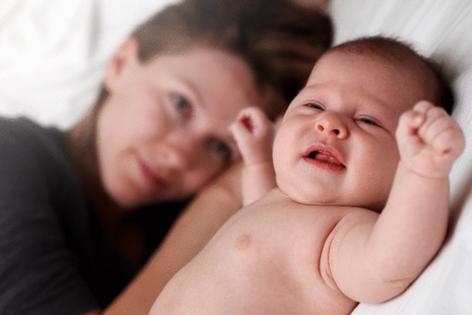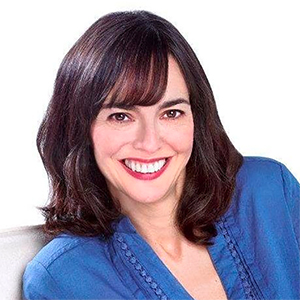'We can't just teach abstinence': How advice on bed-sharing with a baby is evolving
Published in Parenting News
When Emily Little gave birth to her first child, sleeping together with her baby in bed was a given — despite all the public health messages telling her not to.
"I knew it was something that I wanted to do," said Little, a perinatal health researcher and science communications consultant who has studied cultures around the world that bed-share. Little was drawn to the skin-to-skin closeness she could maintain with her baby throughout the night, and the ease of breastfeeding him without getting up. It felt natural to sleep the way mothers and babies had slept "since the beginning of human history," she said.
So she began to research ways to reduce the risk to her baby. Bed-sharing has been found to be less risky for full-term infants in nonsmoking, sober homes who are exclusively breastfed: Check. Only the breastfeeding parent should sleep next to the baby: Check. Since babies are less likely to suffocate on firm mattresses and without loose bedding, Little replaced her pillow-top mattress and got rid of all of her blankets and extra pillows. Because babies could fall off the bed or into a gap between the bed and the wall, Little pushed the bed up against the wall, and filled in the gap with foam.
Still, Little's decision conflicts with advice from pediatricians and public health advocates, who warn that bed-sharing increases the risk that a baby will die during the night. For decades, U.S. pediatricians and public health officials have been warning that the only way to avoid sudden unexplained infant death (SUID) is to stick to the "ABCs of safe sleep" — always have the baby sleep Alone, on their Back, in a separate Crib empty of any pillows, blankets, stuffed animals and crib bumpers. One controversial campaign even depicted a baby lying next to a meat cleaver, sending the message that parents could be deadly weapons when sleeping next to a baby.
And it worked: The rate of sleep-related infant death declined significantly after the safe sleep campaigns began in the 1990s. But in recent decades, the rate has plateaued and even started to tick upward again, at the same time that bed-sharing has become more popular among parents. So some advocates are instead shifting to a "harm reduction" approach that acknowledges parents want to sleep with their infants and offers tips on how to make it as safe as possible.
"Abstinence-only messaging hasn't worked, and parents often aren't honest with their pediatricians when they're asked. We all need to acknowledge that it's practically inevitable," said Susan Altfeld, a retired University of Illinois- Chicago professor who studied bed-sharing. "Developing new messages to educate parents on what specific behaviors are especially risky and what they can do to reduce those risks have the potential to effect change."
A shifting message on infant bed-sharing
About 3,700 infants die suddenly and unexpectedly each year in the U.S, a number that has remained stubbornly high for decades, according to data from the U.S. Centers for Disease Control and Prevention. The risk of sharing sleep surface is real: Infants who sleep with adults are two to 10 times more likely to die than those who sleep alone in a crib, depending on their specific risk factors, the American Academy of Pediatrics, or AAP, wrote in its most recent safe sleep guidelines.
Nonetheless, the percentage of parents in the U.S. who said they usually bed-share has grown, from about 6% in 1993 to 24% in 2015. And in 2015, 61.4 of respondents reported bed-sharing with their infant at least occasionally. Although more recent national data are not available, more than a quarter of mothers in California said they "always or often" bed-shared in 2020-22.
La Leche League International, a breastfeeding advocacy organization, offers the "Safe Sleep 7" on their website to help parents bed-share more safely. Little codified her own "harm reduction" advice for safer bed-sharing in an online discussion guide for other parents to help encourage nuanced conversation between parents and healthcare providers to help mitigate the risks of what is at least an occasional practice for most parents. She also touts the positive aspects of bed-sharing and helps families mitigate the risks.
Babies who share a bed with their mothers, for example, have been shown to breastfeed longer. Parents who plan ahead and bed-share more safely may avoid falling asleep accidentally with a baby in the most unsafe of situations — a reclining chair or sofa. And many parents feel it strengthens their bond with their baby, she said.
"Infants have the biological expectation to be in close contact with their caregivers all the time, especially in the early months," Little said. "Denying that because we as a society are unable to have a conversation about risk mitigation and harm reduction is really doing a disservice to infant well-being and mental health."
Pushback from safe sleep advocates
The pediatrics academy, in its 2022 guidelines, acknowledges that parents may "choose to routinely bed share for a variety of reasons," and offers a few safety suggestions if a parent "unintentionally" falls asleep with their baby. "However, on the basis of the evidence, the AAP is unable to recommend bed sharing under any circumstances," the guidelines state.
It's almost impossible to assess whether a family is truly a low risk when it comes to bed-sharing, especially as many are not forthcoming with their physician about drinking, smoking and drug use, said Dr. Rachel Moon, a pediatrician and researcher at the University of Virginia medical school, and lead author of the AAP report. Even if a parent is a low risk some nights, when they have a glass of wine one evening, they suddenly tip into a high-risk category, she said.
Moon said bed-sharing advice has been a topic of conversation for years in the academy, but given the evidence of risk, the group decided to warn against the practice in all situations.
"It's not responsible for us to give [parents] permission," said Moon, who deals with sleep-related deaths in her role as a researcher. "Every day I deal with babies who have died, and if it happened in a bed-sharing situation, [parents] regret it. I deal with this enough that I don't want anybody to have that regret."
Changing the messaging on safe sleep would be a "slippery slope," said Deanne Tilton Durfee, executive director of the Inter-Agency Council on Child Abuse and Neglect, which runs L.A. County's safe sleep campaign. "You have to be extremely clear with messaging" because many parents may not pay attention to the details, she said.
In 2024, 46 infants in Los Angeles County died as they slept, and almost all of them involved bed-sharing, Durfee said.
The reality in parents' homes
Pachet Bryant, a mother in Mission Viejo, felt deeply committed to sleeping with her new baby from the moment she gave birth. "You're growing a baby for nine to 10 months, and all of a sudden for them to be separated from your heart, from your presence, from your smell, can be traumatic," she said.
But she wanted to do it as safely as possible. So when lactation consultant Asaiah Harville began to work with her, the consultant offered tailored advice to the new mother's situation, which Bryant took "very, very seriously." Bryant had already been doing some research of her own and was able to modify her space accordingly. She also reevaluated every night whether she felt it was safe for her baby to sleep in the bed; on nights when she was too exhausted, she put her daughter to sleep in a bassinet instead.
"We know that parents are either intentionally or unintentionally at some point going to wind up falling asleep with their baby, and we have to think about creating the safest possible environment for that," Harville said. In the lived reality of an individual family's home, she said, "we can't just teach abstinence."
____
This article is part of The Times' early childhood education initiative, focusing on the learning and development of California children, from birth to age 5. For more information about the initiative and its philanthropic funders, go to latimes.com/earlyed .
©2025 Los Angeles Times. Visit at latimes.com. Distributed by Tribune Content Agency, LLC.










Comments